|
We know the names Parker, Waterman, Conklin and Delta, which are modern
day pens known all over the world.
But do you know Pele Kan, Gafar, Tarbut or Atam? Strange names from far away places
but nevertheless fountain pens we should know. The success of modern (post 1884
Waterman) pen manufacturers have always inspired others in many countries to produce
their own brands for local markets. Many were shamelessly copied designs or similar
elements of design to attract customers to lower priced brands with similar appearance.
Others were superior quality with unique and improved functions, using beautiful
materials in celluloid, ebonite and acrylics. Writing instruments with strong
local identity and brand names, have also become popular collectibles with individuals
dedicating years of research and study to document their history. Almost every
country has produced pens that are unique and worthy of recognition, each has
a history and a story to tell.
Israel ben-Sinai, dedicated pen collector from Israel and member of the
Israel Pen Club, PCA and WES presents the story of his research and collections
of writing instruments made in Palestine and Israel.
Katab Brand
Brothers Walter and Eric Kornfeld, who escaped from the Nazis in Austria,
established a factory for the manufacture of fountain- and mechanical
pencils in Ramat-Gan, a suburb of Tel-Aviv, in 1938. The factory was
located on 30 Bialik Street on the second floor of a two-story building.
They were not connected in any way to the writing equipment industry
but nevertheless established a successful business, trading under the
name of KATAB. The name, as written in English is not a Hebrew word
but rather Arabic and the meaning is either "wrote" or "a
written document", while in Hebrew the word as spelled may mean,
as a verb, "has written" or again "a written document".
If the Kornfeld family had only aimed at the Jewish customers, they
would have written KATAV.
By using KATAB they had in mind the Arab population, which at that time was
at least twice in size as compared to the Jewish population. Many of the Arabs
were illiterates, but those who could afford quality pens would have liked, and
still like, nice objects - preferably incorporating gold metal. Therefore, the
very first KATAB models were of very good quality, with gold plated accessories,
in particular a small embossed golden seal on the screw cap, about where the clip
ends. Examples of these pens are very rare.

KATAB c1940. design
similar to Wahl Gold Seal, notice gold seal emblem on cap
During WWII, raw materials were scarce so the family re-cycled used
plastics and managed to continue production. Obviously the recycled
plastic pens are not of the best quality.
Once the war ended in May 1945, they continued production. After the State
of Israel was established (15th of May 1948) there was a big shortage of foreign
funds (ships loaded with grain for flour waited outside the harbors until their
cargoes were paid for). The Katab factory had to adapt once again to a further
shortage of raw materials but managed to continue production. The obvious difference
in the products was the inscription:
Until 15 May 1948 pens carried an imprinted panel:
KATAB  Made
in Palestine Made
in Palestine
From 15 May 1948 the imprint changed to:
KATAB  Made
in Israel Made
in Israel

Note: the  symbol
indicates a locally made product symbol
indicates a locally made product
The factory owners were quite innovative and made pens that used bottled ink
or cartridges (their own standard). The filling systems were chiefly button fillers
but they also made lever fillers and twist (piston) fillers. Katab was basically
a good manufacturer due, most probably, to the skill of its workers and the serious
attitude of its owners. The nibs were always made of 14 Karats gold with iridium
tips and carried the letter K. As far as I know, they were all imported, though
I have heard that some nib manufacturing (or repair) was taking place locally.

KATAB c1940. Design similar to Wahl
Eversharp Skyline
I have in my collection examples of several designs - although not
of the very rare and expensive ones which can cost as much as 10,000
Israeli Shekels (approximately US$ 2000)! Middle range models are available
for about half that price and the third category can be found for about
2,500 Israeli Shekels.
Some pens can still be found in their original cases with a label of
"Mass Knia" (Purchase Tax) or "Mass Motarot" (Luxury
Tax!). If the small label is intact, or if a pen bears the original
price tag, I consider it never to have been used.
As the ball pen became so popular, during the early fifties, the Katab
Company wanted to go into ball pen manufacturing. Actually I found one
ball pen marked “KATAB” and also a brass ballpoint refill
marked “KATAB”. However, the young State had its own ideas
on private industries, which were not to the likings of the Katab owners.
Thus, I assume, the ballpoint pen was manufactured for Katab by another
firm. The family left for the U.K. and the factory closed its doors
in 1954. Its last location was on Bialik Street in Ramat-Gan on the
second floor of a two-story building, with shops on the street level.
The form and shape of both the pen and the refill are very similar to
the Globus ball pen refills, thus, I presume, it was manufactured for
Katab by the other Israel ball pen manufacturers and indicated Katab's
intention to go into ball pen manufacturing.

Katab Palestine
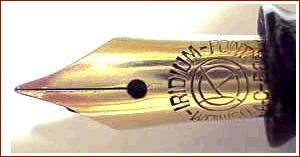
Gold K nibs
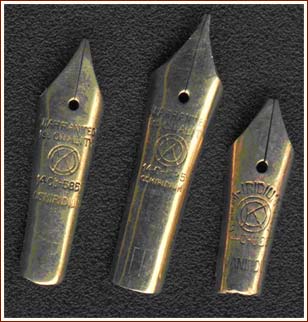
Katab Nibs (courtesy of Dr. Elisha Freund
whose Father was foreman in the “Katab” factory)
Two knowledgeable gentlemen still live in Israel. One is named Moshe
Hacohen of Tel-Aviv who followed the Israeli (Palestinian) pen manufacturing
industry more closely than I have, being engaged all his life with pens.
However, since he expressed his desire to write himself on Katab, I
got only some pieces of information although I offered to compensate
him for his time. The other is Mr. Yair Nachmani of Haifa who maintains
a pen shop in partnership with his son Avraham, from whom I bought several
unused Katab as recently as January 2003! Those pens were made in Israel
for a period of time just before the closing of the factory. Incidentally,
Mr. Yair Nachmani was good enough to give me, free of charge, all his
junk of pen parts he collected during the years. It was in that junk
that I discovered the Katab ball pen refill. These pen parts still hide
a lot of information, which I intend to write about in the future in
updated issues of my article. In addition, the son of Yair Nachmani
who is an expert in repairing pens, seems to find new lots of pens every
so often. Unfortunately, Yair Nachmani's memory is not too good, so
I get from him only little information. Nevertheless, his contribution
to my knowledge is substantial.
I could not find as yet any printed information concerning the Katab factory,
except two advertisements attached at the end of this article. The verbal information
from the two sources sometimes varies. Thus, for instance, Mr. Hacohen claims
that all Katab pens had nibs embossed with the letter K (there is one little exception
to this) while Mr. Nachmani senior claims that not all pens had gold nibs and
not all the nibs carried the letter K. I saw one example of a genuine Katab nib,
which was not made of gold.
Ads and Posters Contemporary
to the Pens’ Production
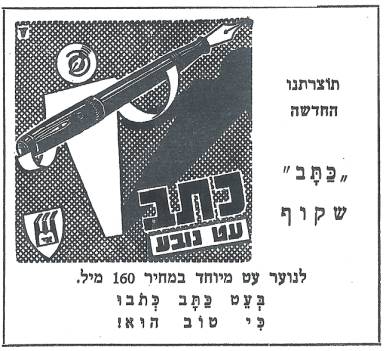
An ad for a transparent fountain pen
" Katab” costing 0.16 of a lira (ca. one English pound)
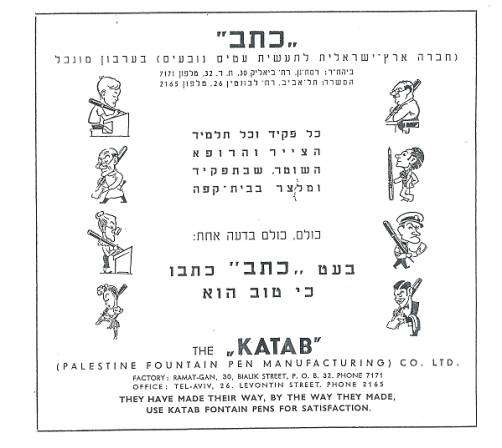
An ad for a “Katab” Fountain
Pen including a citation by the Hebrew poet Abraham Shlonski reading:
“Write with a Katab pen
Because it is best”
In Hebrew the words "write" and "best" rhyme.
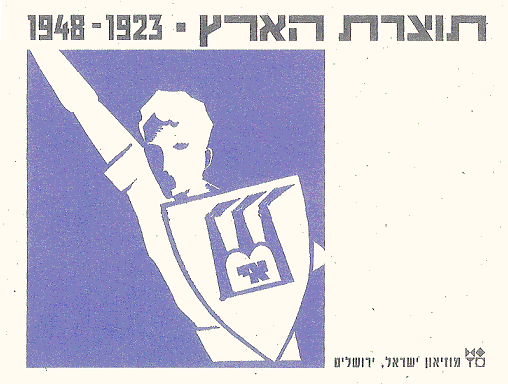
The mark of production of the item is
Eretz Israel, the name of the Jewish state being established in the Middle East,
which became the Jewish state of Israel on May 15th 1948. All “Katab”
pens carry this mark.
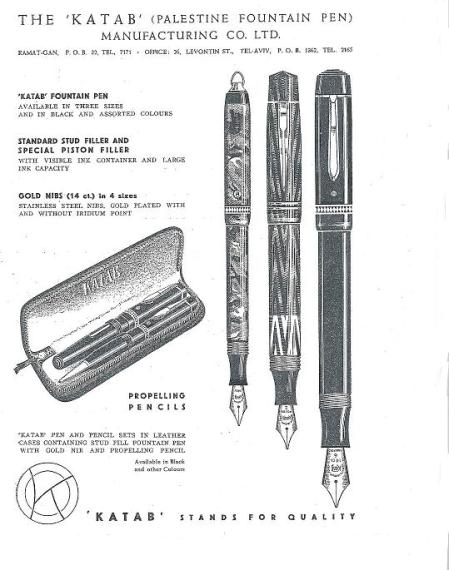
|